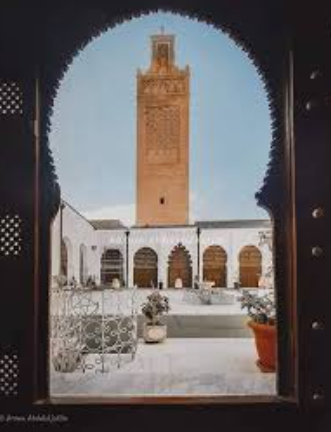
The Great Mosque of Tlemcen was built in 1136 by Ali Ben Youssef, caliph of the Berber dynasty of the Almoravids, and its minaret in 1236 by Sultan Zianide Yghomracen Ibn Zyan. It is built of stone, brick and plaster.
The mosque’s floor space measures roughly 50 by 60 meters (160 by 200 feet). Despite having a normal rectangular floor plan, the mosque’s northwest corner has been blunted due to the former existence of a palace on this side. It has an internal courtyard and a prayer hall in the hypostyle found in most mosques in North Africa (sahn). The 13 naves or aisles of the prayer hall are separated by 12 rows of horseshoe arches that run parallel to the wall of the southeast qibla.
Two transverse rows of arches – one on the south side of the courtyard and another roughly midway between the courtyard and the qibla wall – also include polylobed arches, and another polylobed arch runs transversally before the bay in front of the mihrab (niche indicating the direction of prayer) (niche symbolizing the direction of prayer). The centre aisle is bigger than the other aisles and is located in front of the mihrab. The ornate ribbed dome at the centre of this aisle, in front of the second row of transverse arches, was probably constructed by Yaghmorasan in the 13th century.
The bay in front of the mihrab is covered with an additional ornamental dome that is older and more complex. There are marble columns in several of the arch pillars near the mihrab. The mihrab itself is a wall alcove that is framed by intricately carved stucco decoration and opens through a horseshoe arch. The mihrab of the Great Mosque of Cordoba’s mihrab serves as a general architectural model for the mihrab’s overall design.
The intricately ribbed dome in front of the mihrab, which was renovated by Ali ibn Yusuf, is regarded as the pinnacle of Almoravid architecture. The dome’s structure is entirely ornamental and is made up of several ribs or crossed arches that look like a 12-pointed star. Additionally, it has a screen of carved and perforated arabesque and openwork decoration that covers the crevices between the ribs, making it somewhat transparent and enabling some outside light to pass through.
The intricately ribbed dome in front of the mihrab, which was renovated by Ali ibn Yusuf, is regarded as the pinnacle of Almoravid architecture. The dome’s structure is entirely ornamental and is made up of several ribs or crossed arches that look like a 12-pointed star. Additionally, it has a screen of carved and perforated arabesque and openwork decoration that covers the crevices between the ribs, making it somewhat transparent and enabling some outside light to pass through.
The current minaret was only erected in 1236 by Yaghmorasan, suggesting that the original Almoravid mosque was devoid of a minaret. The brick minaret has a standard square floor layout and is 6.3 meters (21 feet) on each side. It has a two-tiered shaft, with the primary shaft standing at 26.2 meters (86 feet) in height and an additional lantern tower bringing the overall height to 29.15 meters (95.6 feet). Sebka designs are carved into panels that adorn the four faces of the main shaft of the minaret, which are supported by engaged columns below. The unevenness of the ornamental panel on the courtyard side, as well as the distance between the engaged columns on the opposite.
An interesting detail is the unevenness of the ornamental panel on the courtyard side. The sebka pattern above it is unevenly spaced because the engaged columns on the left have a bigger gap between them than the others.
The Great Mosque of Tlemcen, like the other Almoravid Maghreb mosques, with naves (balatat) perpendicular to the qibla wall and rectangular sahn (courtyard) with riwaq (galleries) on the short sides, represents a Maghrebian archetype of architecture religious. The original plan (which did not include the two new galleries opposite the minaret) is rectangular, but amputated by a triangular surface on its northwest side. The length of the whole is approximately 55 meters, and the width a little less.
The prayer room is divided into thirteen podiums (alleys). Seven balatat extending those of the prayer hall frame the court on each side (four on one side, three on the other).
The entrance is surmounted by a sedda (mezzanine) from where the a’yat (shouter) echoes the summons of the imam.
Disclaimer : Mopsqpedia is a non-profit database. All images featured in the database are sourced from various references, publications, and websites related to mosque architecture. Mosqpedia does not claim ownership of any images unless explicitly stated. Images are provided solely for educational and bibliographic purposes. Mosqpedia disclaims any responsibility for copyright infringements related to the images displayed. Users are responsible for verifying copyright status and obtaining permission from original sources if they intend to reproduce, distribute, or use any image beyond fair use.
I agree to the terms outlined below:
You agree to upload and assign Mosqpedia Database the rights to use the content worldwide and in perpetuity across all current and future media platforms. Mosqpedia Database may edit, copy, adapt and translate your contribution.
The content will be distributed under the Creative Commons Attribution-Deed – Attribution-NonCommercial-NoDerivatives 4.0 International – Creative Commons
All data will be stored in line with data protection regulations.
I agree to the terms outlined below:
You agree to upload and assign Mosqpedia Database the rights to use the content worldwide and in perpetuity across all current and future media platforms. Mosqpedia Database may edit, copy, adapt and translate your contribution.
The content will be distributed under the Creative Commons Attribution-Deed – Attribution-NonCommercial-NoDerivatives 4.0 International – Creative Commons
All data will be stored in line with data protection regulations.